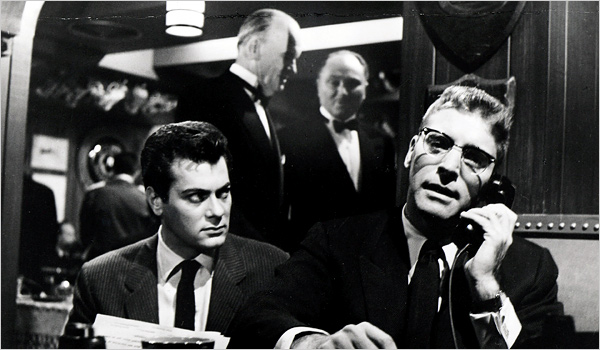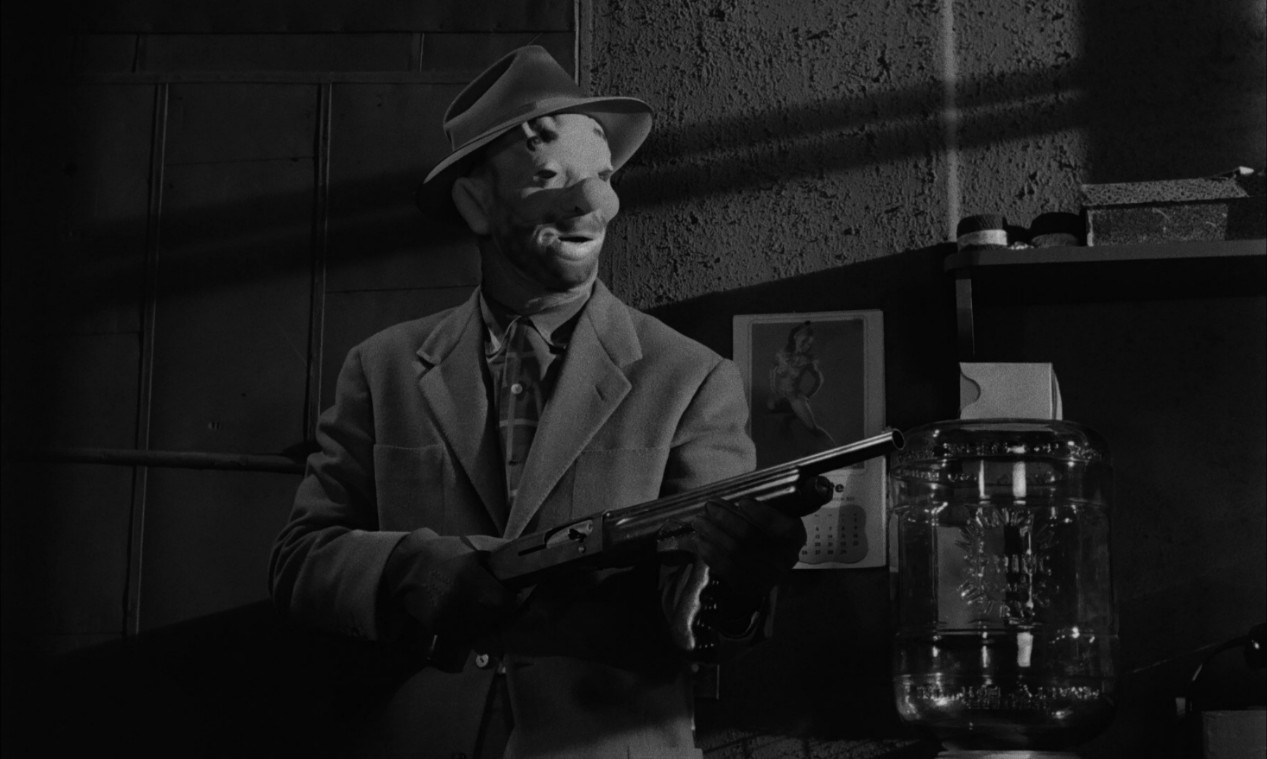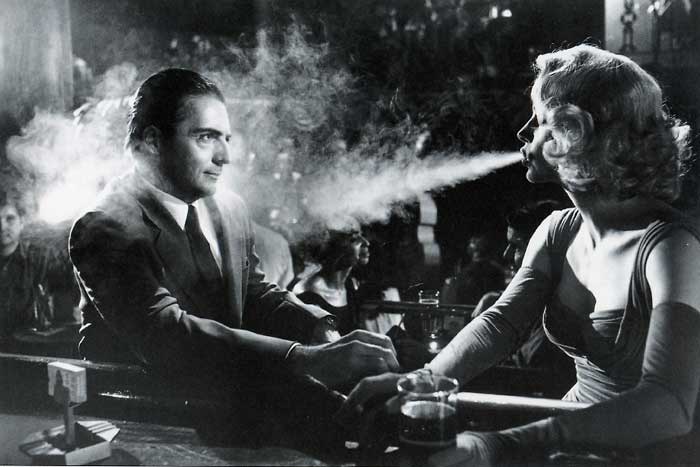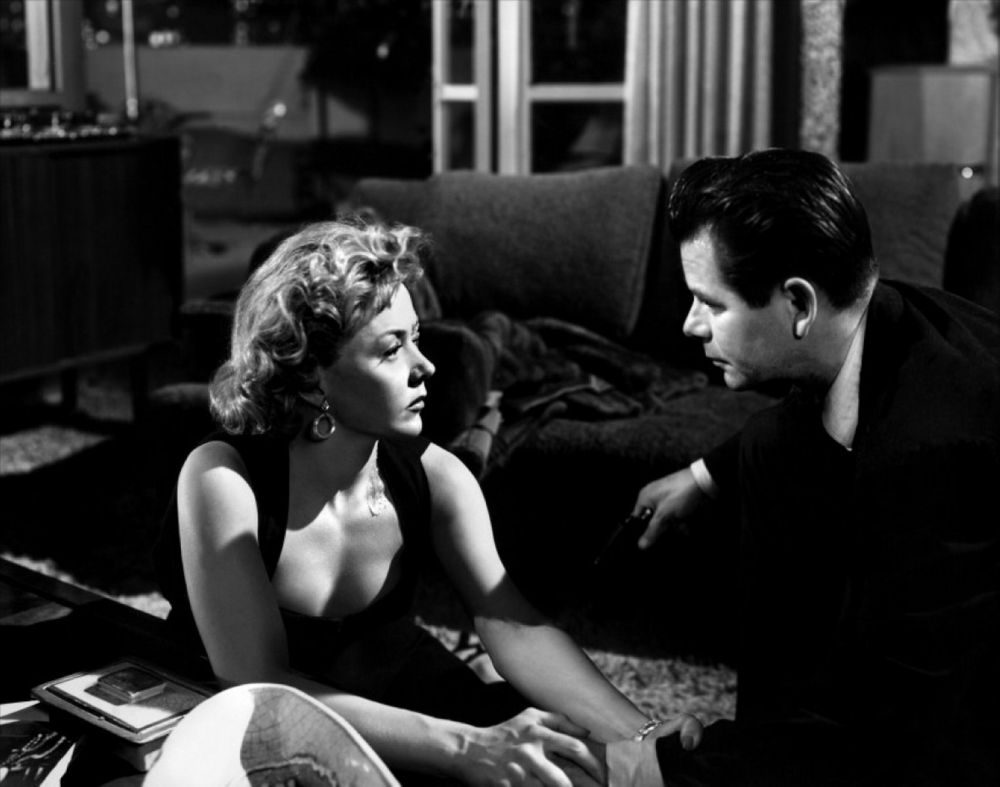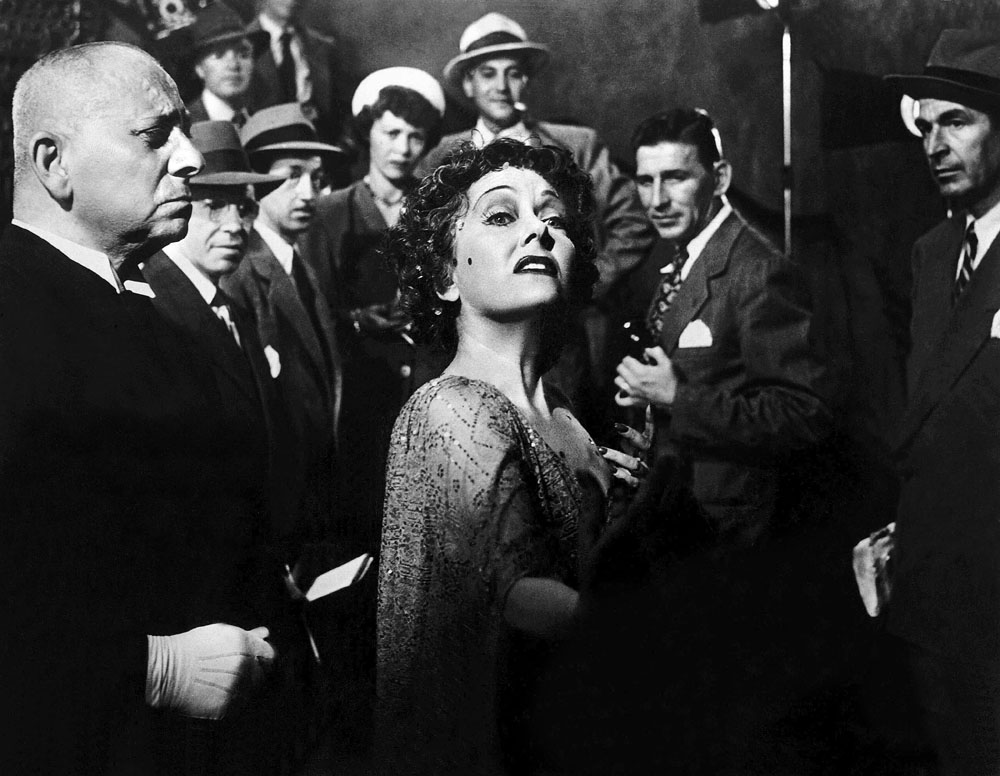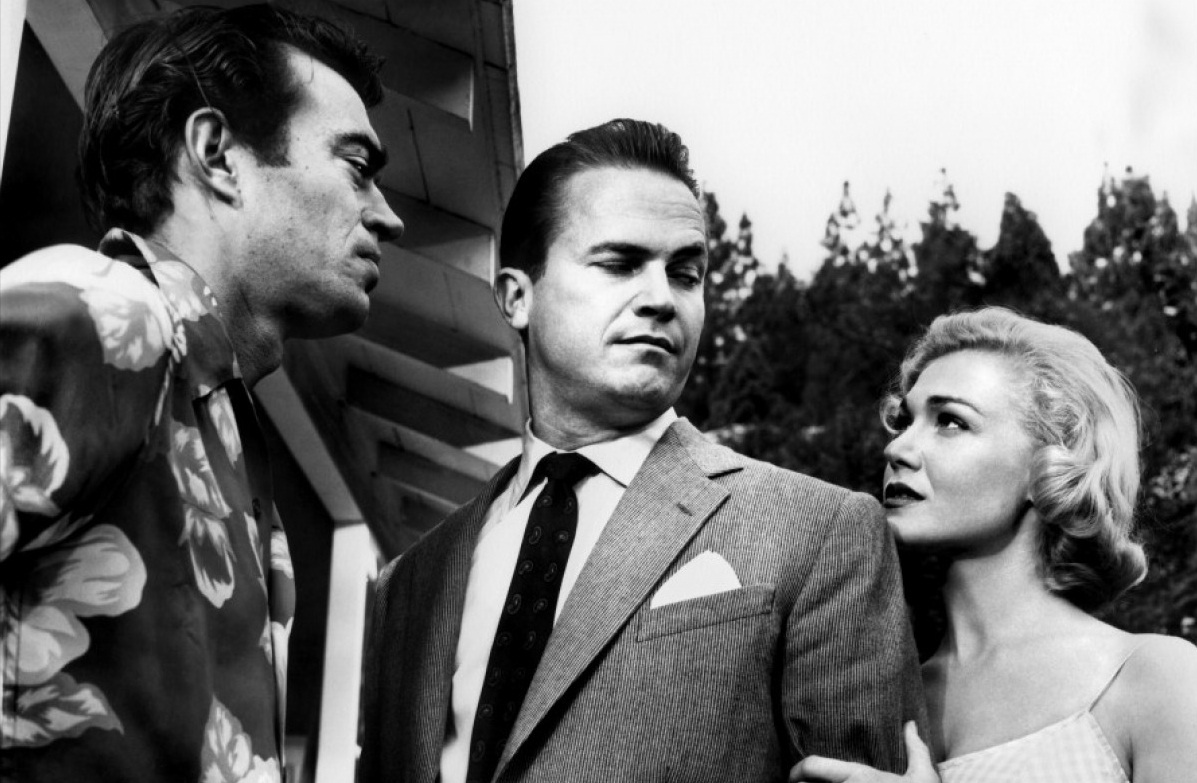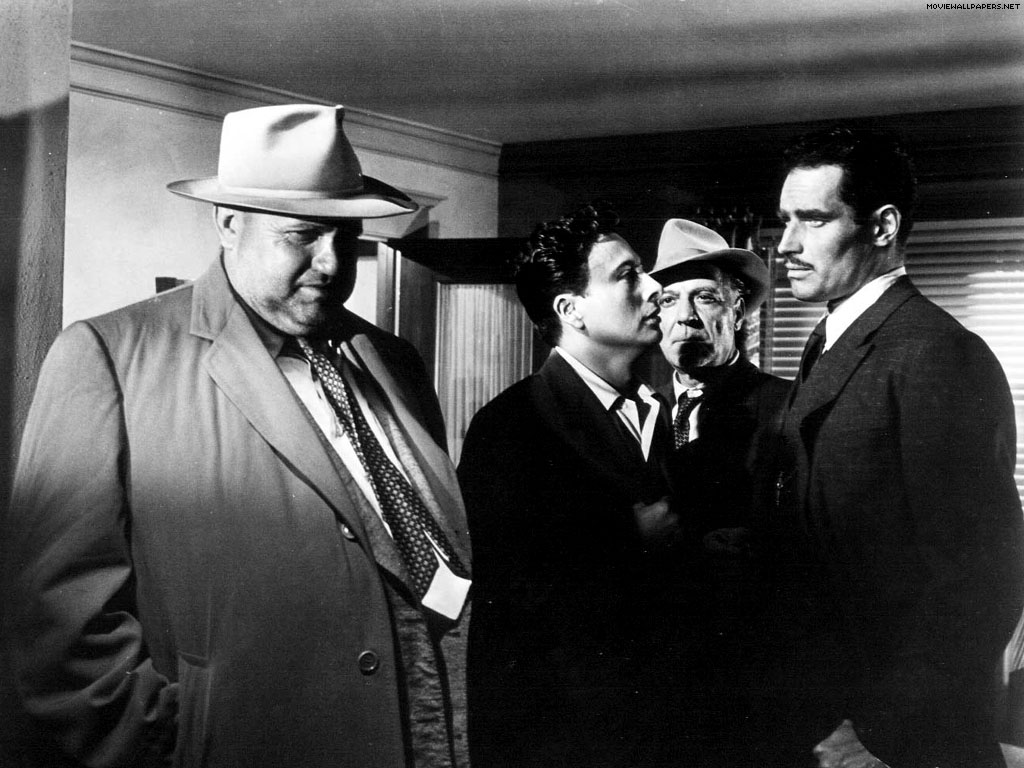8. Sweet Smell of Success (1957)
As the 1950’s wore on, film noir expanded stylistically in ways that would have been unheard of a decade earlier. A great example of this is Sweet Smell of Success, featuring Tony Curtis as Sidney Falco, a theatrical agent who will do anything to place an item in the column of powerful columnist JJ Hunsecker (Burt Lancaster). Hunsecker wants to break up his sister’s relationship with jazz musician Steve Dallas (Martin Milner) and pressures Falco into having an item planted in a rival column that Dallas is a pot smoking commie. The plan seems to work until Dallas confronts JJ and insults him; the columnist then forces Falco to actually frame the musician with drugs.
Shot on location in the mean streets of New York by British director Alexander Mackendrick and based on a short novel by Ernest Lehman, Sweet Smell of Success proved too harsh for 1950’s audiences and failed at the box office (sense a trend here?) but the film’s cynical, unrelentingly harsh vision proved more acceptable to audiences over time, and the film is now regarded as a classic. Barry Levinson paid homage to the film in his own Diner (1982) by having one character do nothing but walk around quoting lines from the film. If you’re going to quote from a movie, it might as well be this one, right Sidney?
7. The Killing (1956)
Young director Stanley Kubrick got his first opportunity to make a Hollywood feature with The Killing, when partner James B. Harris purchased the rights to Lionel White’s novel. Kubrick authored the screenplay with hard boiled writer Jim Thompson. The story is about a heist headed by Johnny Clay (Sterling Hayden) who assembles a team in order to rob the money counting room of a horse racetrack during a big race.
The most notable element of The Killing is the non-linear style of storytelling that Kubrick employed, as the audience gets the details of the big heist from the character’s various points of view. This style was a big influence on later directors, most notably Quentin Tarantino, who utilized this technique in his breakthrough 1992 film Reservoir Dogs. The Killing was a box office failure on its initial release, but was critically praised and Kubrick went on to make his signature early film, Paths of Glory, a year later. The Killing features a great cast including Hadyen, Elisha Cook, Jr., Ted de Corsia, Marie Windsor and Vince Edwards as the thief who tries to steal from the crooks.
6. The Asphalt Jungle (1950)
Another caper film noir featuring Sterling Hayden is the Asphalt Jungle, directed by John Huston. Co-starring Sam Jaffe as “Doc” Riedenschneider, the Asphalt Jungle is the story of jewel heist masterminded by Doc after his release from prison. His team included Dix Handley (Hayden) who wants to use the money to buy back the Kentucky horse farm lost by his father. The operation is financed by crooked lawyer Alonzo Emmerich (Louis Calhern) who says that he will pay the robbers and fence the jewelry himself; Emmerich, however, has a double cross planned. The jewel robbery succeeds, but one of the robbers is accidentally shot by a security guard during the heist. Finally, Doc and Dix figure out that the lawyer does not have their best interests at heart and the entire plan begins to fall apart.
The Asphalt Jungle is notable for an early appearance by Fox contract girl Marilyn Monroe as the young girlfriend of Emmerich, and for the contradiction between the harsh, urban ‘asphalt jungle’ that Dix and his cohorts inhabit and the beautiful, rural horse farm to which he dreams of returning. Dix makes it in the end, but as a typical noir protagonist, his future seems bleak. The Asphalt Jungle is a typical strong effort of John Huston, who directed the first (The Maltese Falcon) and many other fine film noir over the years.
5. D.O.A. (1950)
Released very early in the decade, D.O.A. stars noir regular Edmund O’Brien as Frank Bigelow, as small town accountant who leaves his girlfriend Pamela and comes to San Francisco for a vacation. Frank meets some people and goes to a Fisherman’s Wharf nightclub for a night of wild jazz, where his drink is poisoned by a mysterious stranger. The next day, Frank wakes up not feeling well and after going to a doctor he is told that he has swallowed a poison which will give him only a few days to live. The rest of the film involves Bigelow sorting out the reasons that someone wanted him poisoned and, in effect, solving his own murder.
As was more typical of the previous decade’s film noir, D.O.A. is told in voice over flashback, as Bigelow recounts the events that have led him to be ‘D.O.A.’ at the Los Angeles police station. Directed by former Cinematographer Rudolph Mate and featuring a cast of noir regulars including Pamela Britton, Beverly Garland and Neville Brand, D.O.A. has a unique storyline and was remade in 1988 with Dennis Quaid and Meg Ryan. Our advice: see the original!
4. The Big Heat (1953)
A brutal and violent story of the clash between a gang of criminals and upright police detective Dave Bannion (Glenn Ford) is kicked off when fellow police officer Duncan commits ‘suicide’ under mysterious circumstances. Investigating the case, Bannion comes into contact with syndicate boss Lagana and his second-in-command Vince Stone (played by a menacing Lee Marvin, a dozen years or so before he attained film stardom).
When Bannion’s car is blown up and his wife killed, the policeman resigns the force and goes on a crusade for justice. Bannion stands up to Stone when he tries to bully a woman in a night club, and Stone’s girlfriend Debby Marsh (Gloria Grahame) speaks to Bannion on the street afterwards about her boyfriends nefarious activities. For her efforts, she has a pot of hot coffee thrown in her face later by the vicious Stone. Disfigured, she helps Bannion bring down Stone and Lagana. Suffice it to say, The Big Heat is a tough, gritty crime film, directed with the usual style by noir regular Fritz Lang. A must see.
3. Sunset Boulevard (1950)
Billy Wilder essentially brought the first, ‘classic’ period of film noir to a close in 1950 with Sunset Boulevard, his story of a faded silent film star, Norma Desmond (Gloria Swanson) who takes in a struggling young screenwriter, Joe Gillis (William Holden). Joe is to write Norma’s ‘comeback’ film, but merely ends up a gigolo and her kept man. He finally tries to break away from his keeper when young studio reader Betty Schaefer (Nancy Olson) takes an interest in a script that he has written and begins to meet him late at night to help him finish the story.
But things go wrong when Norma becomes jealous, and Gillis cannot escape from the spider’s web in which he is enmeshed. Finally, he ends up floating in the pool as the assorted media gather and the newsreel cameras roll for Norma’s great final scene: “I’m ready for my close up now, Mr. De Mille!” With former silent film director Erich Von Stroheim along as the creepy butler (and Norman’s ex-husband) Max, Sunset Boulevard has become an iconic film, the classic story of faded tinseltown in decline and the dangers along the way on the boulevard of broken dreams.
2. Kiss Me, Deadly (1955)
Film noir was violent in the 1940’s, but became even more violent and brutal in the 1950’s as the production code slowly lifted. First and foremost of this new breed of protagonists was Mickey Spillane’s Mike Hammer, portrayed in this film by the brooding Ralph Meeker. One night driving on a dark road, Hammer picks up Christina (Cloris Leachman in an early appearance) hitchhiking wearing nothing but a trench coat. When Christina is killed and Hammer ends up in a hospital, he begins a search to find out what the young woman – who had recently escaped from a mental institution – was so afraid of when Hammer encountered her.
With the help of his trusty secretary Velda, Hammer finds Lily Carver (Gaby Rodgers), Christine’s roommate who is after, what she calls “the great whatsit”, a box that turns out to contain a dangerous, glowing substance that Lily thinks is worth a fortune. The explosive end of the film reveals the truth about “the great whatsit” and the people who are after it, and indicated a new direction for noir films in which the growing paranoia about atomic and nuclear power would replace the genre’s former pre-occupations.
Kiss Me Deadly was shot quickly in and around Los Angeles by director Robert Aldrich, who would later make such classics as Whatever Happened to Baby Jane (1962) and The Longest Yard (1974). The film’s ending was changed and altered after its release, but the original ending has finally been restored and the film has been released properly on blu-ray.
1. Touch of Evil (1958)
By the end of the decade, film noir as a style had mostly petered out. When Universal hired star Charlton Heston to appear in a thriller with Janet Leigh and Orson Welles, Heston assumed that Welles would direct the film and insisted that Universal give him a chance. With little time to prepare, Welles re-wrote the script based on the novel Badge of Evil and turned it into a memorable classic, featuring cameo appearances by Hollywood friends Marlene Dietrich, Zsa Zsa Gabor and Joseph Cotton.
Heston is Miguel Vargas, honeymooning in a Mexican-American border town with wife Suzy (Leigh). He is on his way to Mexico City to testify against the drug lord Grandi, but is drawn into the investigation of the explosion death of an American contractor that he and Suzy witness. The investigation is handled by police captain Hank Quinlan (Welles) and his faithful assistant Menzies (Joseph Calleia) who suspect the man was killed by Sanchez, a shoe clerk who was living with the murdered man’s daughter against his wishes. When sticks of dynamite are found in Sanchez’s apartment, Quinlan thinks he has his killer but Vargas thinks the evidence has been planted and sets out to reveal a pattern of police corruption on Quinlan’s part.
Quinlan eventually convinces Grandi’s brother, Uncle Joe (Akim Tamiroff) to kidnap Suzy and discredit Vargas by planting drugs on her. Touch of Evil features one of the most justifiably famous long shots in the history of film, the three plus minute opening shot in which the camera follows Vargas and Suzy walking near the car after a time bomb has been planted in it, until the bomb finally explodes. Welles bold visual style was so potent and daring but was unconventional, and Universal reshot and reedited the film in the hopes of making it more commercial.
After dying a quick death at the box office, the reputation of Touch of Evil grew over the years (as did almost all of Welles’ films) until the film was restored and re-released in 1998 with as much of Welles’ original vision as possible included. Touch of Evil is a journey into a nightmare world of corruption, sin and evil, created by a visionary director and master filmmaker, and had a substantial influence on many films that came after it – particularly Hitchcock’s Psycho – but it also largely signaled the end of the era of the film noir. See it and see it as many times as you can.
Author Bio: Jim Davidson is a 1980 graduate of Northwestern University’s Radio-TV-Film Dept. He lives in the San Francisco Bay Area and has been a video producer since 1987. Jim has written articles for Images Film journal and is currently working on a book about the movie Harold and Maude.
